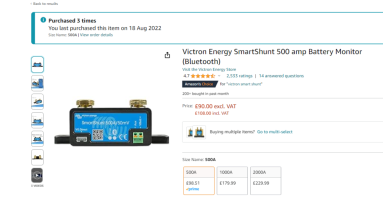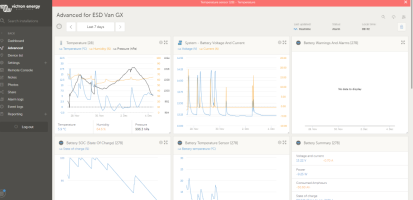Evening folks,
Typical me, wanting to tinker and upgrade a perfectly good campervan already....having done a decent amount of research and looking at what the latest models of kit are, I'd be very grateful if somebody (@Dellmassive ?) could give me a quick sense-check please, before I go and blow (more of) my pocket money. My buddy @Jeff G and I have chatted about it for hours and exchanged many texts, poor guy must be bored to tears!
Context:
Brand new van build by All Seasons, T6.1 SWB Highline T28, collected 3mths & 3.5k miles ago. All working perfectly well, this is absolutely not a "I'm disappointed" thread, and is something I had in the back of my mind from Day 1, it's just that All Seasons build "their build" as they know how, and that's perfectly fair.
Current setup:
As mentioned, I always did want to install a Lithium LB and having read many of @Dellmassive threads (thank you) I'm going to need to address a few things to make this happen.
Another upgrade I want to do is install an inverter. Much as I like the portability of things like Bluetti and EcoFlow packs, I don't really want to cart around another unit. What I would like to do is be able to use the (hardwired in) microwave whilst not on EHU, as well as any power supplies for other gadgets, which can't run from USB.
I've just ordered the Renogy 1kW inverter, on special deal until the end of play today, and that also gives me their UPS function to auto-switch from Inverter to EHU, with a remote unit to switch it on.
When I go for a Lithium LB (possibly a Roamer under-seat 230Ah but that is looking top-end ££'s), then I'll need to do a couple of things:
Some questions....
Same for the Sargent power unit/MCB/RCD board - it's all neatly installed and integrated with a built in touch screen into the kitchen splashback panel, so that's staying.
So, inverter project first, then the battery swap with all the other stuff at some point in the next few months. Comments and suggestions welcome.
Thanks, Spencer.
Typical me, wanting to tinker and upgrade a perfectly good campervan already....having done a decent amount of research and looking at what the latest models of kit are, I'd be very grateful if somebody (@Dellmassive ?) could give me a quick sense-check please, before I go and blow (more of) my pocket money. My buddy @Jeff G and I have chatted about it for hours and exchanged many texts, poor guy must be bored to tears!
Context:
Brand new van build by All Seasons, T6.1 SWB Highline T28, collected 3mths & 3.5k miles ago. All working perfectly well, this is absolutely not a "I'm disappointed" thread, and is something I had in the back of my mind from Day 1, it's just that All Seasons build "their build" as they know how, and that's perfectly fair.
Current setup:
- Hankook DC27 90Ah AGM leisure battery under drivers seat
- Victron Orion 12|12 DC-DC charger, also under drivers seat
- Sargent EC700 power unit + touchscreen controller/info display
- Sargent PX300 charger
- Photonic Universe PU1024B PWM 10A Solar controller
- Single solar panel on the pop-top - I don't actually know which manufacturer but it looks identical to the one sold by Van Junkies - my only thinking is that I'm sure All Seasons told me it was a 160W panel, not the 200W panel linked here. I'll clarify this week.
- Dometic CRX50 fridge
- Dometic 700W microwave
- Webasto heater (air and water)
As mentioned, I always did want to install a Lithium LB and having read many of @Dellmassive threads (thank you) I'm going to need to address a few things to make this happen.
Another upgrade I want to do is install an inverter. Much as I like the portability of things like Bluetti and EcoFlow packs, I don't really want to cart around another unit. What I would like to do is be able to use the (hardwired in) microwave whilst not on EHU, as well as any power supplies for other gadgets, which can't run from USB.
I've just ordered the Renogy 1kW inverter, on special deal until the end of play today, and that also gives me their UPS function to auto-switch from Inverter to EHU, with a remote unit to switch it on.
- Planning on installing this under the drivers seat next to the LB, keeping the wires short, then running the 240v cabling discretely behind the kitchen units to the Sargent EC700, to ensure RCD's are in the circuit.
- Also planning on taking a piggyback from the back of the 2x 13A sockets out to the Renogy AC input, for that UPS function.
When I go for a Lithium LB (possibly a Roamer under-seat 230Ah but that is looking top-end ££'s), then I'll need to do a couple of things:
- Switch over the Victron Orion to change it from AGM to Lithium
- Change the PWM solar controller, as it's a PITA to change its charging profile.
- There's a User Defined mode, but that'll be down to me to program that in, using a Chinglish app, and at the end of the day it's still only PWM controller rather than MPPT. For the cost of a Victron MPPT unit, I can't be bothered, I'll switch it out.
- The MPPT unit I'm thinking should be ok with my current single panel is the Victron 75|15...some of this depends on what the spec of my panel turns out to be....but I'm wondering whether to go larger for the MPPT in case I ever add a second solar panel in the future?
- The Sargent PX300 charger doesn't list Lithium as a chemistry it can support....it gives a nice graph of their charging profile, but if it's not specific to Lithium, I'm not taking the risk.
- Looking at the Victron Blue Smart IP22 12v/30A single output. Not seen any commentary so far on the 3x output version - I think that may be over-complicating things, single output should be fine, right?
Some questions....
- The Blue Smart charger - I see mention of Night mode for quiet operation. This will be mounted in place of the Sargent PX300, in my wardrobe area by the bed. The fact it has fans concerns me, I don't want to be hearing this thing in operation. Ideally, at all. Do I need to be worried about this, or do they run silently in all but the most depleted of battery situations?
- Whilst I'm at it, is it worth installing a smart shunt? Where would the "smarts" of a shunt plug in to? What does it buy me, over using the Victron apps for the Orion, MPPT and Charger?
Same for the Sargent power unit/MCB/RCD board - it's all neatly installed and integrated with a built in touch screen into the kitchen splashback panel, so that's staying.
So, inverter project first, then the battery swap with all the other stuff at some point in the next few months. Comments and suggestions welcome.
Thanks, Spencer.













